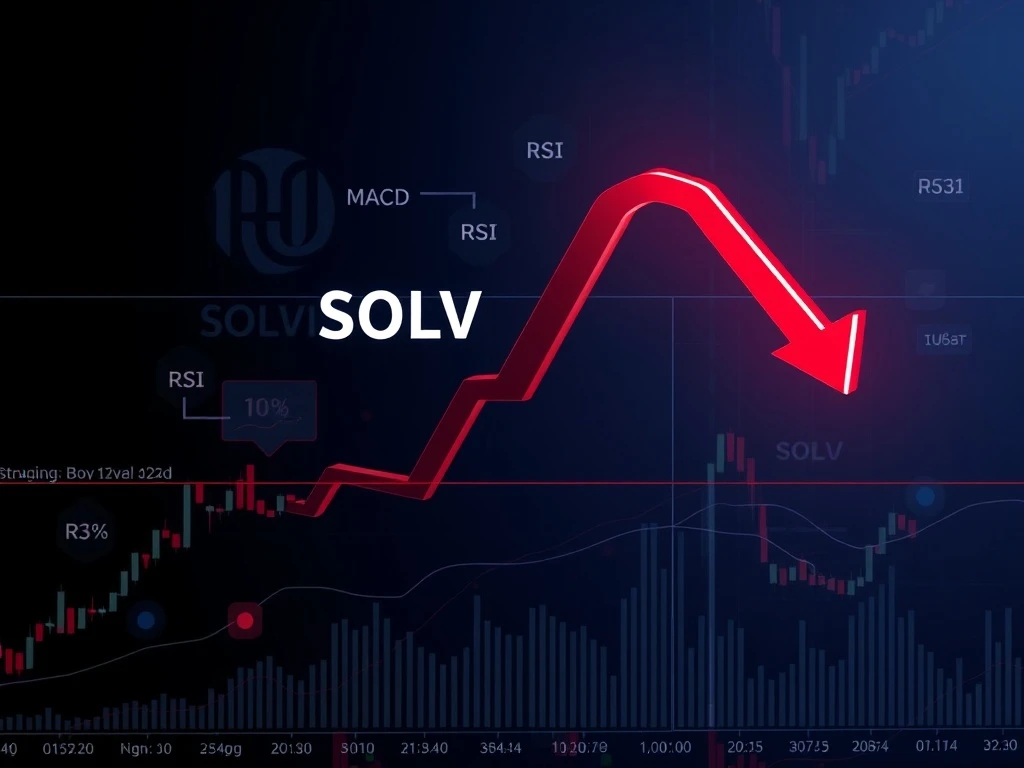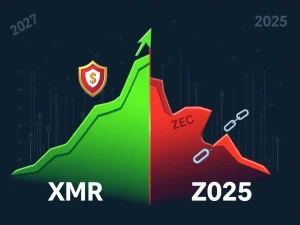Solv Protocol (SOLVUSDT): Unpacking the Alarming Bearish Bias in Latest Market Analysis

Are you keeping an eye on Solv Protocol (SOLVUSDT)? The crypto market is a dynamic beast, and recent movements for SOLVUSDT suggest a period of significant caution for traders and investors. Despite attempts at recovery, the digital asset appears to be grappling with a persistent bearish bias, painting a complex picture for its immediate future. Let’s dive deep into the latest crypto market analysis to understand what’s truly happening under the hood.
Decoding SOLVUSDT’s Recent Price Action: A Snapshot
The past 24 hours have been telling for SOLVUSDT. After a failed rebound attempt from the 0.04102 level, the asset traded within a narrow range, exhibiting a clear bearish sentiment. A critical resistance level at 0.04138 proved to be a formidable barrier, effectively capping any significant upward momentum. Volume distribution remained mixed, indicating indecision among market participants.
Here’s a quick overview of SOLVUSDT’s performance over the 24-hour window from July 24, 12:00 ET, to July 25, 12:00 ET:
| Metric | Value |
|---|---|
| Opening Price | 0.04129 |
| Closing Price | 0.04145 |
| 24-Hour High | 0.04162 |
| 24-Hour Low | 0.04060 |
| Total Volume | 16.24 million units |
| Total Turnover | ~$681,720 |
Notably, volatility saw an increase between 05:00–09:00 ET, culminating in a consolidation phase between 0.0414 and 0.0416. This suggests that while price movements were sharper, they ultimately led to a period of tight range trading, indicating a struggle between buyers and sellers.
Navigating the Charts: Key Resistance and Support Levels for Solv Protocol
A closer look at the 15-minute chart reveals a clear bearish bias for Solv Protocol. The failed attempt to break above 0.04138 highlights this resistance as a significant hurdle. On the flip side, a crucial support level was identified near 0.04102, which managed to hold during a sharp dip in the early hours of July 25. This level will be paramount to monitor in the coming hours.
Candlestick patterns offered mixed signals. A potential bullish engulfing pattern emerged around 05:00–05:15 ET, but unfortunately, it lacked the necessary volume to confirm a sustained reversal. Later, a doji appeared at 19:45 ET near 0.04124, signaling market indecision and a balance between buying and selling pressures at that specific point.
When applying Fibonacci retracement levels to the July 24–25 swing, we find that key levels acted as price anchors:
- 0.04138 (38.2%): This level acted as significant resistance, stalling upward movement.
- 0.04125 (50%): A mid-point that saw price interaction.
- 0.04102 (61.8%): This level provided crucial support during dips, preventing further declines.
The price’s interaction with these levels confirms their importance in dictating short-term movements. The inability to sustain a move above 0.04138 after dipping to 0.04102 suggests that bullish momentum is struggling to gain traction.
What Are Technical Indicators Telling Us About SOLVUSDT?
For a comprehensive crypto market analysis, we turn to the insights provided by various technical analysis tools:
Moving Averages: A Downward Trend
- 15-minute Chart: Both the 20-period and 50-period moving averages are trending downward, with the price hovering just above the 20-period Simple Moving Average (SMA). This indicates short-term bearish momentum.
- Daily Chart: A more concerning signal comes from the daily chart, where the 50-day Moving Average (DMA) has crossed below the 100-day DMA, forming a classic bearish crossover. Furthermore, the 200-day DMA remains above the current price, reinforcing a long-term bearish outlook for Solv Protocol.
MACD & RSI: Cautionary Signals
- MACD (Moving Average Convergence Divergence): The MACD line crossed below its signal line in the early hours of July 25. This is a classic bearish momentum shift signal, suggesting that selling pressure is increasing.
- RSI (Relative Strength Index): The RSI dipped below 30 in the 03:00–04:00 ET window, signaling oversold conditions. Typically, this would precede a strong rebound as buyers step in. However, in this instance, it failed to trigger a sustained reversal. This lack of a strong bounce from oversold territory suggests that buyers are hesitant to enter the market, even at lower price points.
Bollinger Bands: Hinting at a Breakout?
The Bollinger Bands showed a recent contraction between 04:00–05:00 ET. This narrowing of the bands often precedes a period of increased volatility and a potential breakout or breakdown in price. For most of the 24-hour window, price action remained within the bands, with the last candle closing near the upper band. While this might suggest increased volatility, the overall context of bearish bias implies that a breakdown is more likely if key support levels fail.
Volume Dynamics: Is the Bearish Bias Sustainable?
Volume provides crucial context to price movements. For SOLVUSDT, volume spiked during the 02:45–03:00 ET window and again in the 05:00–06:00 ET period. These spikes coincided with sharp price movements, indicating active trading during those periods. However, during the rebound attempts, volume remained below average. This is a significant red flag, as strong reversals typically require robust buying volume to confirm their validity.
Notional turnover saw an increase in the morning hours, but a divergence between price and volume during the 06:00–07:00 ET consolidation suggests potential exhaustion of buying pressure. Low volume on upward moves, coupled with relatively higher volume on downward movements, often reinforces a bearish bias.
Looking Ahead: Critical Levels for Solv Protocol Investors
The crypto market analysis for Solv Protocol points to a challenging period ahead. The immediate focus for traders and investors should be on the 0.04102 support level. A sustained break below this point could trigger renewed and intensified bearish pressure, potentially leading to further declines.
Conversely, for a bullish reversal to be confirmed, SOLVUSDT would need to achieve a sustained move above the 0.04138 resistance level, ideally accompanied by significant volume. However, given the current mixed momentum and volume signals from the technical analysis, caution remains warranted.
Monitoring volatility and volume over the next 24 hours will be crucial for discerning clearer directional clues. The market remains in a delicate balance, and decisive moves will likely depend on whether buyers can finally step in with conviction or if sellers continue to dominate.
Frequently Asked Questions (FAQs)
What is Solv Protocol (SOLVUSDT)?
Solv Protocol is a decentralized finance (DeFi) platform that focuses on creating and trading financial NFTs (Non-Fungible Tokens) called Vouchers. These Vouchers represent various financial assets, allowing for fractional ownership and new forms of liquidity in the DeFi space. SOLVUSDT refers to the trading pair of the Solv Protocol token against USDT (Tether), a stablecoin.
What does “bearish bias” mean in crypto trading?
A “bearish bias” indicates that the general sentiment or trend in the market for a particular asset is negative, suggesting that prices are more likely to fall than rise. This is often characterized by lower highs, lower lows, and increased selling pressure.
How do technical indicators like RSI and MACD help in analysis?
The Relative Strength Index (RSI) is a momentum oscillator that measures the speed and change of price movements. It’s used to identify overbought or oversold conditions. The Moving Average Convergence Divergence (MACD) is a trend-following momentum indicator that shows the relationship between two moving averages of an asset’s price, often used to identify bullish or bearish crossovers and momentum shifts.
What are the key support and resistance levels for SOLVUSDT?
Based on recent price action, the key resistance level for SOLVUSDT is around 0.04138, which has capped upward movements. The critical support level is identified near 0.04102, which has provided a floor for recent dips. These levels are crucial for traders to watch for potential reversals or continuations of the current trend.
Should I be concerned about the current SOLVUSDT market?
The current crypto market analysis indicates a bearish bias for SOLVUSDT, with several technical indicators supporting this view. While market conditions can change rapidly, the lack of a strong rebound from oversold conditions and the holding of resistance levels suggest caution is warranted. Investors should conduct their own research and consider their risk tolerance before making any decisions.
What do Bollinger Bands indicate in this context?
Bollinger Bands measure market volatility. A contraction of the bands, as seen in SOLVUSDT, often signals that volatility has decreased and that a significant price move (either up or down) is likely to occur soon. Given the prevailing bearish bias and other indicators, a breakdown below support levels could be a potential outcome following such a contraction.









